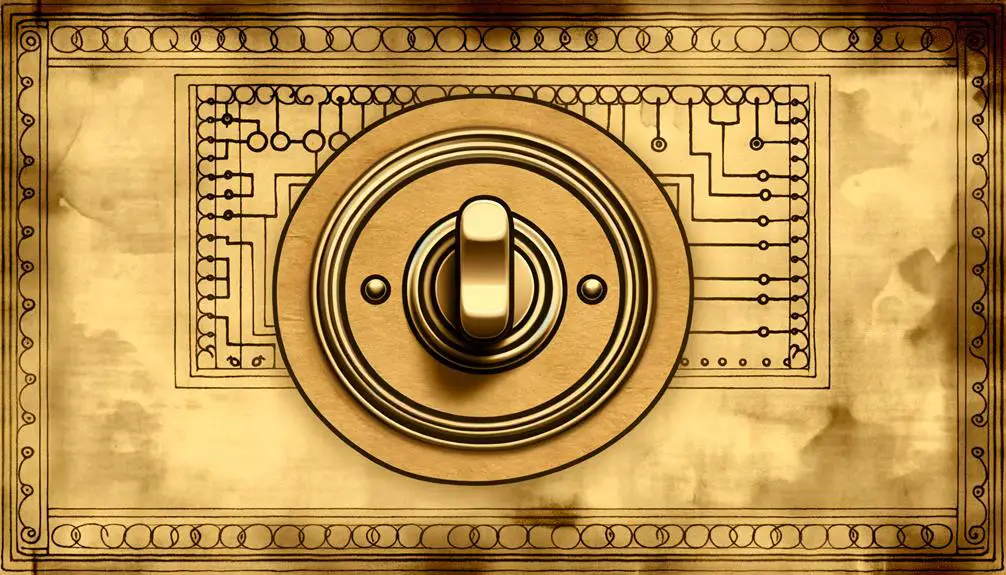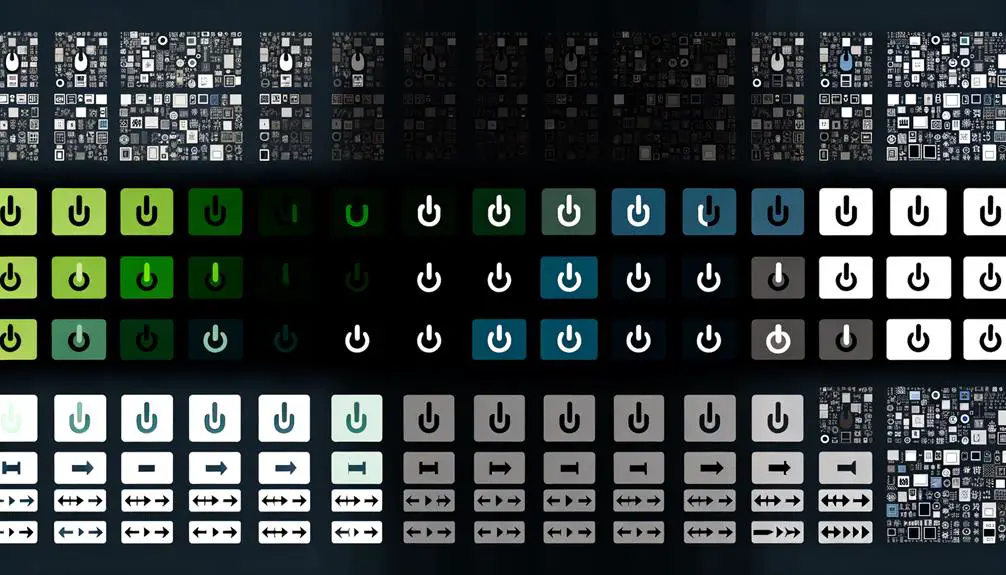What Is the Meaning of Off Switch Symbols?
The on/off switch symbol, originating from early computing and electrical engineering, represents the binary states of power: on (1) and off (0). This symbol, comprising a line intersecting a circle, was standardized by the International Electrotechnical Commission (IEC) for global recognition.
Its design emphasizes visual simplicity, guaranteeing clear functionality and reducing user error. While there are variations like the vertical line, I/O symbol, and toggle switch icon, all reflect the same binary principle.
Adherence to international standards guarantees consistent user experience and legal compliance. To understand its historical evolution and future trends, one can explore additional context and technological advancements.

Key Takeaways
- The on-off switch symbol represents binary states: on (1) and off (0).
- It consists of a line (1) intersecting a circle (0), symbolizing power states.
- Standardized by the IEC for global recognition and consistency.
- Ensures language-independent understanding and reduces user errors.
- Adapts to both digital and analog devices, reflecting varying control nuances.
Origins of the Symbol

The origins of the on-off switch symbol can be traced back to the binary system used in early computing and electrical engineering. Binary notation, fundamental to digital systems, employs two states: 1 (representing 'on') and 0 (representing 'off'). Engineers adopted these binary states to create a universal symbol for power switches. The symbol typically comprises a line (|) intersecting a circle (O), symbolizing the binary digits. The line represents the 'on' state and the circle denotes the 'off' state. This binary-based representation ensured a clear, intuitive understanding across various devices and languages. The adoption of this symbol facilitated standardized communication, aiding in the design and operation of electronic systems globally.
Evolution Over Time
As technology advanced, the on-off switch symbol underwent significant modifications to accommodate evolving design requirements and user interface advancements. Initially, switch symbols were simple binary representations, typically marked by 'ON' and 'OFF' text or a straightforward line-and-circle combination.
With the advent of digital electronics and the need for universal comprehensibility, the International Electrotechnical Commission (IEC) standardized the symbol to a circle intersected by a vertical line, representing the binary states of power. This evolution was driven by the necessity for intuitive, language-independent icons that could be easily recognized globally.
The modern on-off symbol embodies a synthesis of functional simplicity and international standardization, ensuring consistency across diverse technological platforms and user interfaces.
Design Elements

The design elements of the on-off switch symbol are critical for ensuring user interface clarity and functionality. Key considerations include visual simplicity to facilitate quick recognition, symbol color choices to enhance visibility and convey status, and adherence to contemporary iconography trends to maintain relevance in modern applications.
These factors collectively influence the effectiveness and user-friendliness of the on-off switch symbol.
Visual Simplicity
Incorporating minimalist design principles, the on/off switch symbol exemplifies visual simplicity through its simple and universally recognizable form. The symbol, typically a broken circle with a vertical line intersecting it, leverages geometric shapes to convey its function without the need for textual explanation.
This design reduces cognitive load, enabling immediate recognition and comprehension. The minimalist approach not only enhances usability but also ensures the symbol's relevance across various contexts and cultures. By employing a clean, uncluttered design, the on/off switch maintains functional efficiency and aesthetic appeal.
This visual economy is essential in modern user interfaces where space constraints and user attention are crucial. Therefore, the symbol's simplicity is both a design triumph and a functional necessity.
Symbol Color Choices
Choosing the appropriate color for the on/off switch symbol is crucial in guaranteeing both visibility and intuitive user interaction across various interfaces. Effective color choices improve usability and can prevent operational errors.
Key considerations include:
- Contrast: High contrast between the symbol and its background guarantees readability.
- Consistency: Uniform color usage across platforms helps in user recognition and reduces cognitive load.
- Cultural Connotations: Colors often carry different meanings in various cultures; red typically signifies stop or off, while green indicates go or on.
- Accessibility: Guaranteeing color choices meet standards for color blindness (e.g., using both color and shape differentiation) enhances inclusivity.
Iconography Trends
Adopting contemporary iconography trends for on/off switch symbols demands a deep understanding of minimalist design principles and user-centric aesthetics. Modern iconography emphasizes simplicity, reducing clutter to guarantee immediate user recognition.
The prevalent use of geometric shapes, such as circles and lines, is aligned with international standards (ISO 7000). Additionally, scalable vector graphics (SVGs) are preferred for their adaptability across various devices and resolutions.
High contrast and monochromatic palettes further enhance visibility and legibility, essential for users with visual impairments. The integration of responsive design guarantees that symbols remain effective regardless of screen size or context.
Therefore, the current trend in iconography merges aesthetic minimalism with functional clarity, optimizing user interface design for a diverse user base.
Universal Recognition
The universal recognition of the on/off switch symbol is essential for ensuring consistent and intuitive operation across diverse technological devices and settings. This symbol, typically represented by a circle with a vertical line, is designed for immediate and global comprehension.
Key aspects of its universal recognition include:
- Standardization: The symbol is standardized by international bodies, such as the International Electrotechnical Commission (IEC), ensuring uniform application.
- Education: Technological literacy programs incorporate this symbol, facilitating widespread understanding.
- Cross-Cultural Adaptability: Its simplicity transcends language barriers, making it effective in various cultural contexts.
- Compliance: Manufacturers adhere to these standards, promoting consistent user experience across different devices.
This universal recognition is pivotal for reducing user error and enhancing operability in an increasingly interconnected world.
Symbol Variations

Examining symbol variations reveals important insights into common designs, regional differences, and historical evolution.
Variations in the on/off switch symbol can reflect differing standards and cultural interpretations across regions.
Understanding these distinctions is essential for ensuring universal usability and compliance with international standards.
Common Symbol Designs
Various symbol designs for the on-off switch have evolved to accommodate different user interfaces and cultural interpretations. These designs are intended to be universally intuitive, yet they exhibit distinct variations that cater to specific contexts.
Common symbol designs include:
- Circle and Line (IEC 5007/5008): Represents 'power on' and 'power off,' using a circle for off and a line for on.
- Vertical Line (IEC 5009): A single vertical line, often used to denote a toggle function that turns the device on or off.
- I/O Symbol: Combines a vertical line (I) and a circle (O), indicating binary states.
- Toggle Switch Icon: A physical representation of a switch, used in graphical user interfaces to mimic real-world toggles.
These symbols facilitate clear, user-friendly interaction with electronic devices.
Regional Symbol Differences
Although on-off switch symbols are designed to be universally understood, regional differences in design and interpretation can greatly impact user experience and device usability. For instance, the IEC 60417 standard employs the '| ' (on) and 'O' (off) symbols, which are widely recognized internationally. However, in North America, the use of 'I' and 'O' symbols can sometimes lead to confusion due to historical variations and local practices. Additionally, some regions may incorporate additional indicators or colors to signify operational states, further complicating user comprehension. Understanding these regional symbol differences is essential for manufacturers aiming to create globally accessible devices. This helps to ensure that users from diverse backgrounds can operate the devices efficiently, minimizing the risk of misuse or operational errors.
Historical Symbol Evolution
The evolution of on-off switch symbols reflects a complex interplay of technological advancements and standardization efforts across different eras.
Various symbols have emerged to represent the binary states of electrical devices. Notable historical variations include:
- Toggle Switches (Early 20th Century): Simple up/down or left/right toggles, often labeled with 'On' and 'Off'.
- I/O Symbols (1940s): Introduction of binary-inspired 'I' for on and 'O' for off, reflecting the growing influence of digital logic.
- Circle-Line (IEC 5009, 1973): Adoption of a circle for off and a line for on, standardizing symbols for global understanding.
- Unified Power Symbol (2000s): A combination of the previous I/O and circle-line symbols, facilitating universal recognition amidst a digital age.
These developments underscore the dynamic relationship between engineering practices and global standardization.
Psychological Impact
Understanding the psychological impact of the on-off switch symbol necessitates an examination of its influence on user behavior and cognitive processing.
The symbol's intuitive design, typically comprising a broken circle with a vertical line, promotes immediate recognition and reduces cognitive load. This streamlined interaction minimizes user errors and enhances operational efficiency.
The symbol's consistent application across devices fosters a sense of reliability and control, essential for user confidence. Neurological studies affirm that familiar symbols activate specific brain regions associated with memory and decision-making, underscoring the importance of standardized visual cues.
Consequently, the ubiquitous presence of the on-off switch symbol not only simplifies device operation but also reinforces positive user experiences through predictable and efficient interactions.
Legal and Standardization

Building on the psychological benefits of the on-off switch symbol, adherence to legal and standardization protocols guarantees its universal functionality and safety. Regulatory frameworks and standardization bodies guarantee that the symbol is consistently applied across devices, fostering user familiarity and operational reliability.
Key standards and regulations include:
- ISO 7000-5007: Defines the graphical representation of the on-off switch symbol.
- IEC 60417: Encompasses symbols used for electrical equipment, including the power switch.
- ANSI Z535: Addresses safety symbols, guaranteeing that the on-off symbol meets safety requirements.
- RoHS Directive: Ensures that materials used in manufacturing such switches are environmentally safe.
Compliance with these standards is essential for manufacturers to avoid legal liabilities and secure consumer trust.
Digital Vs. Analog Devices
How does the on-off switch symbol differ in application between digital and analog devices?
In digital devices, the on-off switch symbol often represents binary states: a clear-cut '1' for on and '0' for off. This binary interpretation aligns seamlessly with the fundamental logic of digital circuits.
Conversely, in analog devices, the on-off switch symbol signifies a more nuanced control of power. Analog systems may involve variable states, where the switch can regulate a range of voltages or currents.
Thus, while the symbol remains universally recognizable, its functional implications diverge significantly. In digital contexts, it ensures binary operation, whereas in analog systems, it may also facilitate modulation of electrical parameters, highlighting the versatility and adaptability of the symbol across technologies.
Future of On/Off Symbols

While the current applications of the on-off switch symbol vary between digital and analog devices, the evolution of technology necessitates a reevaluation of its future role and design. Emerging trends and innovations suggest that on-off symbols will need to adapt to new contexts and user interfaces.
Key considerations include:
- Touchscreen Integration: As touch-based devices proliferate, traditional physical switches may be replaced by digital icons.
- Voice-Control Compatibility: Voice-activated systems could render visual symbols partially obsolete but will still need a recognizability standard.
- Wearable Technology: Compact, wearable devices might require alternative representations or gestures for on-off functions.
- IoT Devices: The Internet of Things demands a unified, universally recognizable on-off symbol to guarantee seamless interoperability across diverse gadgets.
These changes reflect the dynamic nature of user interaction and technological progression.
Conclusion
The on/off switch symbol, with its rich history and evolution, stands as a proof to the confluence of design, usability, and standardization. Its universal recognition underscores its significance in both digital and analog domains, revealing a profound psychological impact.
As technology progresses, the symbol's adaptability will remain pivotal. Like a lighthouse guiding ships, the on/off symbol will continue to navigate users through the complex seas of technological interfaces, ensuring clarity and functionality in an ever-advancing world.






